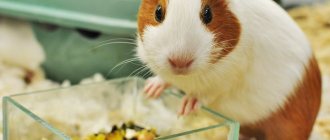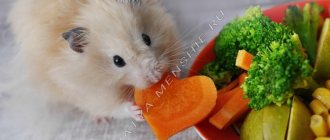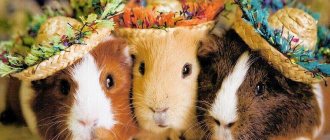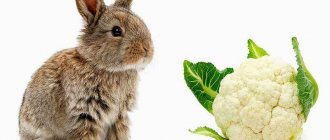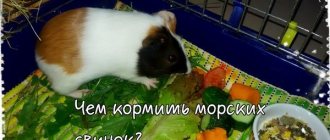Guinea pigs are highly sensitive pets that require careful care, love and attention from their owner. The digestive tract of rodents of this species is designed in such a way that for normal functioning and preservation of health, animals must receive the same food at home as they would receive in their natural habitat. The owner must clearly know what to feed the guinea pig. Adequate nutrition for an animal is a matter of vital importance. In a starving rodent, after a day, the intestines stop working, and the animal dies.
Feeding recommendations
The pet needs to be fed correctly so that its health remains normal, its teeth are strong, and its coat looks well-groomed. Your pet's daily menu should include:
- 50% hay;
- 20% dry food;
- 20% juicy food;
- 10% greens.
An important question for owners is how many times a day to give food to a guinea pig. Feeding is carried out 3 times a day. The feeder cannot be removed from the cage; food must always be available to the animal. There should also always be hay in the cage.
If there is no dry food in the animal’s diet, then it must be replaced with a similar weight of greens and raw vegetables. The menu should be varied; the rodent must be offered at least three different vegetables per day and certainly grass. It is prohibited to give your pet grass collected on the sides of highways and in industrial areas.
The optimal menu is vegetables and fruits before noon, dry food after noon.
Effect on the body
When introduced moderately and periodically into the diet, nuts have a positive effect on the body of domestic rodents. They make it possible to saturate the body with the necessary energy and protect the animal from exhaustion, and this property is especially important for the young and most active animals. In addition, the product provides the body with all kinds of microelements and vitamins that are important for maintaining optimal tone and immunity, as well as the healthy functioning of the cardiovascular system.
In addition, any type of nut contains antioxidants . These compounds are especially important for the body of pets, as they help reduce the impact of free radicals and other harmful compounds on organs and tissues. And this allows you to reduce the risk of developing disorders of both individual organs and various systems.
You should definitely remember that nuts are important for rodents and as a source of external beauty. They are rich in vitamin E, which is considered the best way to protect fur from fragility, loss and other cosmetic problems. At the same time, the vitamin makes it possible to make the coat soft and give it a healthy shine.
Grain feed
A guinea pig needs to eat at least 20% grain per day. Grain food for rodents is sold in any pet store. The finished product usually includes:
- barley;
- oats;
- millet;
- sunflower seeds;
- corn grains.
In addition to grain, prepared feeds may include vegetable granules and vitamin supplements.
Dry pet food is easy to prepare yourself; you just need to buy different types of grains on the market and then mix them. But you need to take into account that the main ingredient is oats; guinea pigs eat it more readily than other grains. Solid grain food should always be present in the diet of rodents. Animals need it to grind down their continuously growing teeth. If a rodent eats only raw and soft food, then its incisors become unnaturally elongated and interfere with the ability to absorb food. As a result, the animal dies from starvation.
Is it possible to give nuts?
As a rule, all kinds of guinea pigs are herbivores. That is why the basis of their diet should be juicy and dry herbs, as well as fruits and berries. It is recommended to feed rodents with cereal grains and various peeled seeds. It is believed that nuts are unnecessary for guinea pigs, since in the wild they eat them quite rarely.
However, this product is still approved for feeding rodents. It has a beneficial effect on the health of individual organs and systems of the body. In addition, nuts are extremely important for the young and most active pigs: they are one of the best sources of energy.
Green feed
This food for guinea pigs is the most healthy and natural. Your pet should eat fresh greens, rich in fiber and nutrients, to maintain normal functioning of the intestinal tract. Below is a list of herbs recommended for guinea pigs:
- cereal sprouts;
- spinach;
- lettuce leaves;
- clover;
- carrot tops;
- beet tops;
- dill, parsley, cilantro;
- plantain;
- yarrow;
- chamomile;
- dandelion leaves.
You need to be very careful when collecting grass for your pet. Among the useful plants there may be poisonous ones. Therefore, you should not put a bunch of grass in a cage without carefully sorting it out first. Fresh greens for your guinea pig should be thoroughly washed.
Diet
Of course, you can reduce feeding your pet to giving him “store-bought” food twice a day. He will eat it, but is it right to eat it? – Yes, if the animal was imposed on you, and your humanistic principle obliges you to give it food. No, if the guinea pig appeared in your house for a reason. In this case, you care about the state of her health and whether she will live a year longer.
When deciding what to feed your guinea pig, it is better to choose between the following options:
- mixed nutrition;
- natural diet.
Mixed nutrition involves feeding both ready-made grain or granulated mixtures and juicy fresh food. Such food can be fruits, melons (melon), sorrel...
Organizing natural nutrition at home will require a lot of effort from the owner. But the feeding process will bring immeasurably more pleasure! And the result - an active, healthy pet with shiny fur - will certainly please you!
Berries and fruits
Fresh fruits and berries are not only treats for guinea pigs, but also vitamins and minerals that pets need. Fruit can be given daily, depending on your pig's personal preferences and veterinarian recommendations.
As a general recommendation, experts advise not to overfeed your pig with sweet fruits. Like no other domestic rodent, guinea pigs are prone to frequent digestive disorders. And an overabundance of tangerines, apples, and pears on the animal menu can lead to failures of this kind.
Tangerines should be given to your pet with special caution. On the one hand, the pig’s body does not produce vitamin C, the richest source of which is citrus fruits. On the other hand, tangerines belong to the group of allergenic products. Tangerines can be offered a slice a day, carefully observing the reaction of the pig’s body.
Green feed
Rodents of the pig family love green food. When collecting dandelion or alfalfa leaves for your pet, choose places away from busy highways.
Rodents of the pig family happily eat clover, nettles, Chinese cabbage leaves, and sorrel. Greens can be selected individually, experimenting with foliage (celery, fennel, basil), shoots and excluding bulbous vegetables. Whatever greens you choose, sorrel, spinach, lettuce - everything that guinea pigs eat must be washed.
In winter, the choice of green food inevitably narrows to the store assortment. So that your pet can eat as many types of succulent greens as possible in winter, you can grow green food yourself. The owner of a guinea pig shares tips on how to do this in this video.
In addition, for the winter it is necessary to prepare hay for the pigs, by eating which the rodents wear down their teeth. Branches of fruit trees are also suitable for stitching.
You can also dry the leaves of sorrel, alfalfa, and clover. Even in dried form, these products contain a large amount of vitamins and microelements.
With the onset of spring, dry hay is gradually replaced by seasonal greens. This transition should be controlled, it should be as gentle as possible so as not to provoke digestive upset. It is not recommended to give grass that is wet from dew or rain to pets.
Grain feed
One of the components of a properly formulated guinea pig diet is grain feed. Rodents will eat wheat, corn, barley grains, lentils, peas, soybeans, sunflower seeds, and oats. You can also give them corn grains in small quantities.
In a properly designed pig menu, the share of grain feed should not exceed a third of the total food volume.
What are the consequences of an excess of grain in a pet’s diet?
- Overly nutritious grain feed will inevitably lead to excess weight gain.
- Grains are a source of a number of vitamins and microelements, but not all. By increasing the proportion of grain feed, the owner thereby reduces the intake of those beneficial substances into the animal’s body that are not found in grain. – They are present in greens, fruits and berries that a pet could eat in a day with a different ratio of diet components.
The animal eats grains only raw. An exception is made only for bread, which some pigs love so much. It is not recommended to give fresh white bread, let alone black bread - only well-dried bread! Rather, it should be bread crumbs. Feel free to give your pet a cracker or two a day: she will sharpen her teeth on it. In addition, the pig’s body will receive the full range of B vitamins contained in the bread.
Combined feeds
Tender greens, fragrant berries, ripe fruits, juicy vegetables and shoots, fragrant hay sufficiently provide the rodent’s body with the necessary substances. This is a natural and the best diet for your pet that can only be provided at home.
At the same time, different types of good feed with herbal and fruit granules attract attention. Mixtures may also contain various types of grains, honey, and dried fruits. And, although rodents of the pig family could easily do without granulated food, some owners still buy ready-made mixtures for their pets.
But, no matter how much manufacturers claim the exceptional benefits of ready-made mixtures, you should not make even a seemingly standard food the basis of a pig’s diet.
And you shouldn’t offer your pet food that contains:
- bone meal (in the wild, rodents of the pig family do not consume products of animal origin!);
- preservatives;
- corn based syrup;
- fructose;
- nuts.
Water and salt
The drinking bowl should be filled with fresh water once a day. If a rodent eats a mixed diet, it will drink more water than if it were on a natural diet. After all, juicy green food contains a lot of liquid, unlike dehydrated food.
If the animal's body does not receive enough fluid, the pet risks getting sick. The organs of the genitourinary system, in which stones can form, will be affected.
The pet needs salt. Like a block of chalk, a wheel of salt is placed between the bars of the cage. Salt contains minerals necessary for the normal development of the rodent. Feeling a lack of these substances, the guinea pig licks the wheel.
Pink wheel with salt
“Forbidden fruits” for rodents
What should you not feed guinea pigs? These rodents are not just vegetarians, they are vegans. That is, in the wild, an adult pig would never even think of drinking milk, much less eating meat. Guinea pigs are not predators.
At home, when preparing food for your pet, you need to take into account the following food taboos:
- milk, cheese, cottage cheese;
- meat fish;
- porridge;
- vegetable stew;
- raw potatoes;
- eggplant;
- night blindness;
- fern;
- wild rosemary;
- sow thistle;
- stick;
- celandine;
- fighter.
Overripe (or unripe) fruits, rotten vegetables, damp grains, expired feed, food from the owner’s table - all this is also “forbidden fruit” for rodents.
Although sorrel is included in the list of permitted foods, it should be given to the pig in small quantities.
Hay
The most important food for guinea pigs. Hay not only normalizes the functioning of the intestinal tract, but is also an excellent tool for grinding down the incisors of rodents. Like grain, hay is sold at any pet store. When purchasing, it is important to carefully check that the dried grass is not affected by mold. Rotten and moldy hay can harm your pet's body. If the owner is engaged in the preparation of hay on his own, then he must carefully inspect the collected grass for the presence of prickly, weeds, and poisonous plants.
Vegetable menu
The main task of vitamin C in the rodent body is to control the functioning of connective and bone tissues. Animals have to look for it from external sources, since the animal body is not able to produce it in such quantities.
Pigs' favorites on the menu most often include apples, carrots and cucumbers. Vitamin C can enter the animal's body through raw food of plant origin. It is important to give them to your pet at least 1 teaspoon per day. Veterinarians also list the following as approved products:
- Zucchini is allowed due to its high content of minerals and pectins, which normalize the functioning of intestinal permeability.
- Carrots have a positive effect on the condition of the animal’s coat and skin, as well as visual and auditory function. You can give not only the fruit itself, but also well-washed tops. Due to the content of Vitamin A, urine may turn orange.
- Bell pepper can be given to animals only during the season, due to the fact that winter varieties are oversaturated with nitrates. Only sweet varieties are allowed to serve as food.
- Pumpkin is also given to the animal almost completely. And zinc contained in the seeds is a strong preventative against helminthiases.
- Cucumbers themselves are low in calories, safe and have the ability to help digest heavy fats.
- Fresh peas are also acceptable, but in small quantities. Despite the disapproval of veterinarians. Some food manufacturers add the essence of the fruit to their mixtures, despite the fact that they can cause a negative side reaction in the animal.
- Cabbage is also allowed, but subject to proper supervision. While it causes gas in some people, excessive use can be dangerous for pigs. It is worth introducing it into the diet gradually, observing the reaction of your friend.
- Rutabaga facilitates bowel movements and helps avoid constipation. Best suited for your pet's winter diet.
- Jerusalem artichoke can be given as a treat, strictly limiting its total amount in the animal’s diet. The root vegetable itself is the most dangerous; other parts of the plant can be given constantly.
The most undesirable products include:
- Tomatoes are especially considered dangerous when green. They contain solanine, in addition, the use of tops is also not recommended. Ripe tomatoes, due to the destruction of poisons, can be included in the diet in small quantities. If you overdo it, the animal may experience intestinal upset and problems with the gastrointestinal tract.
- Potatoes are prohibited due to starch and solanine.
- Melon has a risk of developing diabetes due to the abundance of sugars.
- Radish and radish oils can cause bloating.
- Beetroot has a stable effect and is not particularly recommended for pregnant females. Root vegetables and tops are recommended for healthy individuals in small quantities. After eating beets, the animal’s urine may temporarily acquire a red tint.
- Corn is prohibited for pigs; only tops are allowed. And grains contain a large amount of starch, which can cause obesity.
Juicy plant products
The category of such food products includes vegetables and fruits. The diet should include mainly vegetables; fruit pulp is just a treat for guinea pigs. You should not give your pet too much fruit. Their pulp is saturated with sugars, which in excess are harmful to the body of a small animal. From time to time, the guinea pig is allowed to treat a small amount of cherries, apples, peaches, nectarines, apricots, pears, bananas.
The rodent enjoys eating vegetables and berries:
- carrots;
- white and cauliflower;
- zucchini;
- tomatoes;
- bell pepper;
- cucumber;
- corn;
- pumpkin;
- celery;
- seedless grapes;
- green peas.
It is useful to treat the animal once a week with berries rich in ascorbic acid: strawberries, currants, raspberries, wild strawberries. You can also periodically offer the animal leaves and twigs of cherries, blueberries, raspberries, gooseberries, and mint.
Eggplants and green tomatoes should not be included in the diet; these vegetables contain solanine, a toxic compound also present in green potatoes. It is strictly forbidden to give your pet leeks, onions and green onions. Bulb crops are poisonous to rodents.
Many owners are interested in whether it is possible to treat a guinea pig with melon and watermelon. The animal willingly feasts on such a treat and even eats watermelon rinds with pleasure. But you need to keep in mind that melon and watermelon are very sweet products, so you shouldn’t include them often in your diet.
You can diversify your pet's menu with fresh peas, soybeans, lentils, and green beans. It is useful to give your rodent juicy pea pods, rich in vitamins and nutrients.
Berries and fruits
Natural berries and fruits contain the bulk of the vitamins your guinea pig needs, not just the treats your guinea pig loves. Fruits are not forbidden to the animal; they can be included in the daily diet, the animal will choose what it likes more, and advice from a veterinarian on nutrition is also possible. Veterinarians do not recommend giving your guinea pig a lot of sweet fruits. They are more likely to have indigestion, which occurs more often in them than in other rodents. A large number of sweet tangerines, apples and pears can cause just such a disorder. Give tangerines to your pet with particular care. They are, of course, an essential source of vitamin C, which the pig's body does not produce, and citrus fruits are the main source. But tangerines are strong allergens. You can give a little, a slice every day and watch the behavior of the guinea pig to see if it has developed an allergy.
Additional sources of vitamins and minerals
Most of all, a guinea pig needs vitamin C. Ascorbic acid is not synthesized at all in the body of rodents of this species. Therefore, animals must daily absorb a significant amount of food saturated with vitamin C. Phylloquinone and B vitamins can be absorbed in the guinea pig’s body only after repeated consumption, that is, after the animal eats its own feces. Therefore, a rodent that eats droppings cannot be stopped.
Of the minerals, salts and calcium are especially important for guinea pigs. Therefore, it is recommended to buy mineral sticks for your pet at the pet store. It is also permissible to treat your rodent with fish oil and bone meal as useful supplements.
Grains, nuts and seeds
Most guinea pig owners purchase ready-made grain mixtures. As a rule, animals calmly eat purchased food in combination with succulent foods and feel great for some time. However, if the owner of the rodent did not pay attention to the nutritional pattern of his ward, the animal may soon begin to have health problems.
Some pigs choose from a grain mixture and eat only sweet dried fruits and seeds, which contain a lot of fats and carbohydrates. This often leads to obesity, liver disease, and heart failure. The most common symptoms of animal malnutrition are:
- diarrhea;
- bloating;
- the appearance of dental problems;
- constipation;
- shifting the nutritional balance from succulent feed to grain.
If at least 2 of the listed signs are observed, it is necessary to urgently change the grain mixture. You should choose a composition with a lower carbohydrate content, which has a predominant amount of wild grains.
You can prepare the grain mixture yourself. But it is important to remember that cereals should not be boiled or scalded with boiling water. They are mixed with grains and given to pets in small quantities (30% of the diet).
Table 5. Permitted and prohibited components of the grain mixture.
| Can | It is forbidden |
| Barley grains, lentils, rolled oats, oats (unpeeled), pearl barley. | Millet, corn grits, rice grains, buckwheat. |
When choosing combinations of grain mixtures, it is necessary to take into account the age of the animal, the degree of its mobility, the time of year, and the weight of the rodent. This will help avoid problems with obesity and the development of gastrointestinal pathologies.
Water
There must be a drinking bowl with fresh water in your pet's cage. An adult animal needs 250 ml of fluid per day, but a pregnant female needs a little more. It is recommended to buy a drinking bowl for your pet. In such a device, the water will not become dirty or spill.
It is advisable to give the rodent bottled or filtered water rather than boiled water. The owner must carefully ensure that dirt and debris do not get into the drinking bowl. By consuming contaminated water, your guinea pig can contract an infection.
You should know about this
What could this moment be like? Eating unusual foods can cause the following disruptions in the body:
- allergy;
- problems with the urinary system;
- digestive disorders;
- poisoning
In the event of an allergic reaction, the animal's eyes may become inflamed, nasal discharge may appear, itching, loss of fur may occur, breathing becomes difficult, and the animal becomes apathetic.
Food with a high fat content makes the urine of rodents more alkaline, and this ultimately leads to damage to the kidneys and bladder, and secondary infections.
The reaction of the gastrointestinal tract may be loss of appetite, bloating, diarrhea; The vital activity of the pig decreases.
Well, some cheese ingredients are quite capable of causing acute poisoning with convulsions, vomiting, and excessive salivation. Refusal to eat may occur.
On the list of prohibited foods for guinea pigs, cheese is one of the first items along with sausage and eggs.
If the owner knows that these products are extremely harmful to his pet, he will not even try to treat him with them. And if the pig doesn’t try them, he won’t even know that they exist. And this, perhaps, will benefit her more. Cheese is still a delicacy for mice.
Foods harmful to guinea pigs
The following is a list of foods that can cause serious harm to a rodent's body:
- white and black bread, pasta;
- meat and dairy products;
- potato;
- mushrooms;
- baked goods, sweets;
- cereals, dry legumes;
- fruit and berry seeds;
- radish, radish;
- sorrel, rhubarb;
- juice, tea, jelly and other drinks other than water;
- leaves of indoor plants that are poisonous to rodents;
- canned food, spices, cheese and other delicacies;
- waste from the human table.
Guinea pigs love to chew on young tree branches. You should not give your pet oak, willow, pine, spruce, rowan, hornbeam, or elm branches. But you can safely put cherry, hazel, plum, apple, and pear branches in the feeder.
Nutrition for pregnant pigs and newborn piglets
Pregnant pets must eat well and of high quality. The diet of furry mothers should be rich in proteins and vitamins. It is useful to give pregnant females carrots, beets, and wheat sprouts. You can periodically add a little milk to the water. Rosehip infusion brings great benefits to the body of a pregnant pig.
If the female who gave birth does not have milk, then the owner will have to feed the cubs on his own using a syringe. Artificial food for small piglets includes low-fat cream and the probiotic Linex. The cream is taken into the syringe and a tenth of the probiotic capsule is added to it. The resulting solution is nutritious and beneficial for the digestive system of babies. The food in the syringe is warmed to room temperature. Piglets take 1 ml of food every hour. Two-week-old babies can be switched to cereal porridge without milk. The piglets sit on the porridge until they get used to “adult” food.
Healthy Supplements
The most common dietary supplement is vitamin C, which is diluted in drinks. It is not produced in the body on its own, but if the basic feeding rules are followed, guinea pigs receive it in sufficient quantities from fresh vegetables and feed mixtures. Vitamin C can be used as a supplement only as prescribed by a ratologist; usually such a need arises if we are talking about a weakened stomach or a prolonged period of artificial feeding.
Table of allowed vegetables, herbs, herbs, fruits, berries
Adult pigs require from 10 to 20 mg of vitamin C per day. The need for vitamin C may depend on seasonal fluctuations, under normal conditions, pigs kept in an apartment require from 10 to 15 mg, pregnant females about 20 mg. You can see how much your pigs actually get of this vitamin in the table. Keep in mind that products lose some of their vitamins during long-term storage in winter; vitamin C in them is reduced by an average of 1/3. All data in the table are average values, since the availability of nutrients is influenced by many factors, for example, storage conditions, types of varieties (different types of carrots, different varieties of apples), seasonality, etc. If you give fresh foods, then you shouldn’t give additional vitamin C, because it can only do harm. When there is an excess of vitamin C, the urine becomes acidic and a predisposition to kidney damage and skin irritation develops.
The calcium/phosphorus balance should be 1.5:1. For clarity, these data are shown in the table. In animals with kidney problems, too much calcium in the diet can lead to kidney and bladder stones.
Information
Unfortunately, it is not possible to find out the composition of all crops and indicate it in the list, so for some there is a dash.
Note:
As a rule, you can hear that cucumbers should not be given, because... contain a lot of water and little nutritional value. You can give cucumbers, but in moderation. In addition, one may hear that fresh food is rich in carcinogens and contains many chemicals, as a rule, such remarks are the result of false panic and are quickly spread in the media. In fact, all “harmful” substances are found in fresh foods, usually in very small quantities and do not pose any harm to health. If you see danger in everything, then the animals will simply have nothing to eat. For example, dill, which is now considered very healthy, has been considered dangerous for several years because it contains small amounts of safrole. The proportion of safrole in fennel is so low that it is not even significant for medical reasons. Carcinogenic safrole is effective only in large quantities (for example, in nutmeg, safrole from which is used as a medicine).
Information about substances:
Tannins: tannins include tannin. Its content, especially in the branches of old trees, can reach 20%. Tannin is used both in medicine and for processing leather products. Once in the pig's stomach, tannin is converted into gallic acid. And she, in turn, turns into pyrogallol, which is a poison. In experiments on animals there was an indicative result: pyrogallol changes cells at the DNA level. Hydrocyanic acid: unfortunately, it is still widely believed that tree branches with stone fruits (such as apricots, cherries, plums, etc.) contain hydrocyanic acid. This is not true! They do not contain hydrocyanic acid or amygdalin, which breaks down into hydrocyanic acid and fructose when reacting with water. Amygdalin is a constituent substance in the seeds of fruits, but not in the bark and leaves.
Making a diet for a guinea pig: This question tops the list of tasks that we mentally form when carefully carrying home a funny pet from the pet store. What do guinea pigs eat? Offhand, each of us will say that this must be some kind of grass and grains, perhaps bread. Yes, I remember the seller talked about hay, recommended some kind of food... What kind of food do rodents like? How much grain can they be given per day? What products are included in the ideal menu for rodents of the pig family?
[Hide]

